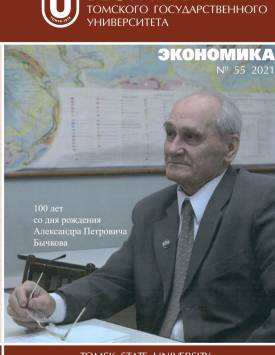Analysis of the Labour Productivity Impact on Indicators of Economic Growth at the National, Sub-Federal, and Regional Levels
Labour productivity has a predominant impact on economic growth and the rate of postcrisis economic recovery. The increase in labour productivity, in turn, depends on the employed population’s standard of living. A comparative longitude analysis of these indicators’ dynamics reveals the potential for the economic growth of the territory. The historically determined asymmetry in the economic development of Russian regions requires analysis carried out at the national, sub-federal (federal districts), and regional levels. In the study, the author evaluates the dynamics of the per capita gross regional product (GRP), labour productivity, and real wages in constant prices at purchasing power parity for Russia, the Siberian Federal District, and Krasnoyarsk Krai. The results of this analysis allow comparing economic growth and labour productivity growth in Russia and Russian regions with international trends. The author has found that labour productivity per working hour measured in constant prices in Russia, Siberia, and Krasnoyarsk Krai is several times lower than the corresponding indicators of countries leading in productivity and economic growth. The dynamics of per capita GRP and labour productivity, measured both in current and constant prices, is positive. The statistical relationship between labour productivity growth and cyclical processes in the national economy is noted; in the crisis and post-crisis periods, there is outstripping growth in labour productivity due to the mobilization of the workers’ labour potential. The economy of the Siberian Federal District has been characterized by a steady excess of the growth rate of labour productivity over the growth rate of per capita GRP, while in Krasnoyarsk Krai and Russia this trend has manifested since 2014 with the onset of the crisis. This process indicates a change in the mechanisms of economic growth: with the entry into the crisis phase, human labour, as well as its efficiency, becomes the only significant factor in maintaining the stability of national and regional economies. The obtained results also show the depressive impact of a long-term decline in real wages on labour productivity and economic growth during the economic crisis. The structural analysis demonstrates that labour productivity growth has a strong positive effect on economic growth, while the growth of the employment rate has a moderate positive effect. A decline in the share of the working-age population in the demographic structure has a pronounced negative impact on economic growth in the long-term period. The study results can be used in the development of national and regional policies related to stimulating economic growth.
Keywords
economic growth, labour productivity, regional economy, structure analysis, dynamics analysisAuthors
| Name | Organization | |
| Samusenko Svetlana A. | Siberian Federal University | sv_sam@bk.ru; ssamusenko@sfu-kras.ru |
References

Analysis of the Labour Productivity Impact on Indicators of Economic Growth at the National, Sub-Federal, and Regional Levels | Vestnik Tomskogo gosudarstvennogo universiteta. Ekonomika – Tomsk State University Journal of Economics. 2021. № 55. DOI: 10.17223/19988648/55/12
